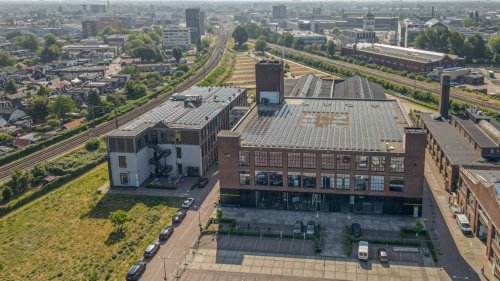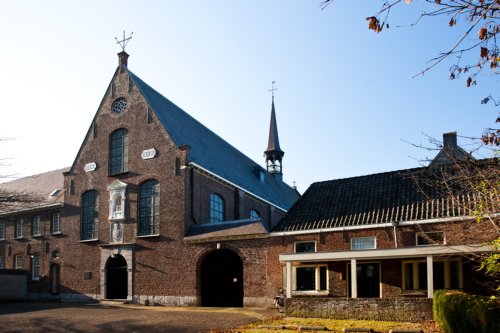UT student Jurjen Koopmans is working on his graduation project in the field of Civil Engineering & Management. His work focuses on the complex challenges that arise during the transformation of listed buildings and specifically obstacles in the design process. “My research aims to contribute to a sustainable future for listed heritage by creating a framework that systematically and clearly presents frequently-occurring design obstacles and links them to relevant solutions.”Once complete, his research can be used as an important tool for designers and contractors dealing with these Dutch heritage icons in practice.
 Historic buildings have played a crucial role in society for decades, forming a part of the cultural identity of communities, while serving as tourist attractions and meeting places that promote social cohesion within the community. In recent years a clear trend can be observed, however, because social and economic developments have resulted in vacancies. This challenge is mainly noticeable in religious heritage, such as churches and abbeys, because as the number of people holding religious beliefs declines, so do the numbers of visitors to these monuments, impacting maintenance and threatening their continued existence.
Historic buildings have played a crucial role in society for decades, forming a part of the cultural identity of communities, while serving as tourist attractions and meeting places that promote social cohesion within the community. In recent years a clear trend can be observed, however, because social and economic developments have resulted in vacancies. This challenge is mainly noticeable in religious heritage, such as churches and abbeys, because as the number of people holding religious beliefs declines, so do the numbers of visitors to these monuments, impacting maintenance and threatening their continued existence.
Generally speaking, demolition and new-build are considered standard methods for reducing vacancy in the built environment. However, when it comes to our cultural heritage, the situation is thankfully a little more subtle. Buildings with a protected status cannot simply be torn down. This protection not only safeguards the preservation of our history for generations to come but also forces us to make a careful consideration between the preservation of monumental value and the promotion of functional use. A balance must be struck between making the building appealing for everyday use without detracting from its historical meaning.
“The challenges go beyond simply preserving existing structures; even changes to the construction are limited due to the need to preserve historical value. This is a dilemma, in which the preservation of cultural heritage must go hand in hand with adjustments for modern usage and that makes this professional field complicated”, Mr Koopmans explains. “Solutions not only need to comply with current safety standards and other requirements resulting from the Building Decree, they also need to be reversible. This means that it has to be possible for any work done to be reversed without causing irreparable damage to the historical elements, as would be the case with chopping, breaking or similar activities. After all, we are only here for a short time and current functions will need to be changed again in the future to suit the needs and wishes of the time.”
Repurposing, creativity and circularity
Repurposing listed buildings not only contributes to the preservation of our cultural heritage, it also fits in perfectly with circular principles. Instead of using new materials and demolishing existing buildings, repurposing ensures that the initial energy put into the building is not lost. Moreover, in the past, people applied fewer industrial processes, and manpower and animals were often used for transport and construction. This way of working combined with the age of the buildings means that, in most cases, the original materials have entirely or almost entirely depreciated over time.
In addition to that, repurposing also promotes creativity and innovation because it requires new ways of thinking about the possibilities for the use of spaces and how they can be adapted to modern needs, while preserving historic and architectural integrity. One such need is energy efficiency, which has become a key consideration due to the fact that climate change has become such an urgent issue in recent decades. Old buildings were generally not designed with energy savings in mind, which can lead to considerable loss of heat and high energy costs. Upgrading insulation is an important but challenging step in this process. For example, insulation on the outside is often impossible due to the monumental value and traditional insulation on the inside threatens the properties of building physics (condensation). Another factor that needs to be considered is the presence of thermal bridges after insulation.
To solve this problem, we look at actual necessity in the case of listed buildings first. Living spaces, for example, are subject to higher standards for thermal comfort compared to spaces with a lot of traffic and post-insulation of the attic floor may be a preferred alternative to insulation of the roof deck if the attic itself is not used. Parts of the building that are difficult to insulate may also be better used as adjoining unheated spaces, which serve as a thermal buffer between the living space and the outside air.
The principles of circularity and creativity also play a role in the selection of insulation materials. Traditional construction often uses synthetic insulation materials such as PIR/PUR, EPS and mineral wools, which have both high insulation values and a high impact on the environment. These insulation materials were not originally used in the construction of listed buildings and, as a result, these buildings have a higher air permeability. This means that there is a risk of potentially building-damaging condensation if post-insulation is performed without the addition of ventilation facilities. In the case of listed buildings, vapour-permeable, bio-based materials such as hemp are also considered for this reason. Although biobased materials generally have a lower insulation value and require more thickness to achieve the same RC values, they are renewable and can be processed in a healthier way.
Of course, this is not only limited to the choice of materials for post-insulation, it also includes the reuse of other building components such as roof tiles, doors, flooring and brickwork. In traditional construction, people prefer everything to be new, whereas in listed buildings, doors that do not close optimally or roof tiles with a little atmospheric precipitation fit in perfectly with the appearance of the premises. Striking the right balance between the preservation of historical values and complying with modern requirements while promoting circular principles is the starting point in this: no deconstruction, burning for energy yield, or even trips to the landfill, but reuse instead!
Limited availability of literature
With the vacancy of listed buildings as a frequently-occurring phenomenon in recent years, you would expect to find a wealth of literature on the topic. However, this is not the case. “Also noteworthy is the lack of extensive literature on frequently-occurring design obstacles and the lack of applicable solutions to these problems. Attention is only given to general considerations associated with repurposing, such as a lack of workmanship, high cost, and availability of traditional materials. As a result, many transformations become trial-and-error processes in practice, due to the lack of a solid foundation, resulting in the loss of heritage.”
Roelofs and Haase
As part of his graduation project, Mr Koopmans is reviewing three case studies that have already (or partially) been repurposed by developer and contractor Roelofs and Haase from Rijssen. Roelofs and Haase is a family business dating back more than one hundred years, that started as a contractor and expanded to include project development activities. Over the last several decades the company has also ventured into the field of listed buildings with a special focus on religious heritage.
Hazemeijer Hengelo
For most people at UT, the Hazemeijer complex consisting of eight former factory halls and located in between the railway connections Hengelo-Zutphen and Hengelo-Deventer, is probably the most well-known asset in the Roelofs and Haase portfolio. In 1914, senior engineer Floris Hazemeijer founded a factory for electrical switch boxes at Tuindorpstraat. Despite its modest beginnings, the company soon grew into an impressive industrial complex, strategically located between the two railway lines. In addition to the production of electrical switch boxes, Hazemeijer founded a separate company for the production of military precision equipment which would come to be known as Hollandse Signaal Apparaten. The company later became Thales Nederland, a leading firm with almost 2,000 employees. In later years, Hazemeijer merged with HEEMAF to create Holec, relocated to the edge of town and ultimately continued its operations under the name of Eaton, which has provided components for the fuse boxes of many households.
Due to this relocation, the complex at Tuindorpstraat became vacant and required a new function. In this process, Roelofs and Haase took over from BOEi and the complex is developing into a mixed-use location, with a technology museum in one of the former factory halls, office space for various companies and a catering facility.

Picture of the Hazemeijer complex in Hengelo
Emmaüs monastery Velp
Another characteristic object in Roelofs and Haase’s portfolio is the Emmaüs monastery in Velp (Grave). This convent is an important part of the Velp Trinity, which represents a rich religious history and consists of the little St. Vincent church from the middle ages, the Emmaüs monastery from the 17th and 18th centuries and the Redemptoristine convent, used during the 19th and 20th centuries during the period referred to as the Rich Roman Life.
Roelofs and Haase have managed to preserve the building’s stunning historical character on both the inside and the outside, while ensuring full occupancy. The convent offers various spaces for courses and meetings, as well as bedrooms for overnight stays and a professional kitchen that uses ingredients from its own monumental garden, while also striving to be an oasis of calm in the hustle and bustle of modern life.
“The great thing about doing this research at Roelofs and Haase is that everything that is researched is also actually implemented. Every day, hundreds of people use these buildings, and that is in addition to all the people who drive by and experience the scarcity of this heritage. I think it is fantastic to be able to map how more of these properties could be successfully transformed and that by working together we can preserve our heritage for future generations. It would be such a waste if these icons were to disappear in the coming decades”, explains Koopmans. He also observes a win-win situation in the acknowledgement of circular and sustainability principles in the repurposing of buildings: an alternative to demolition.

Picture of the Emmaüs monastery in Velp (Grave)





